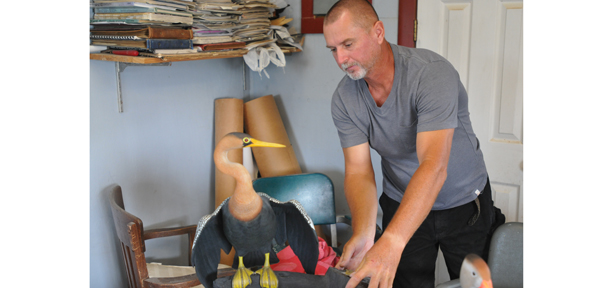
Three generations of the Badeaux family were crowded together over a long paint-spattered table in a raised workshop located right on the bayou off Badeaux Lane in Bayou Gauche.
Coffee cans with well-worn brushes of all different types were pushed towards the middle of the table and surrounded by duck carvings in various stages of completion. A window unit air conditioner hummed in the background.
At one end of the room a workbench filled with wooden handled carving tools, sanders and specialty machines sits. On the other end is a large stack of outdoor manuals featuring birds the Badeauxs model their carvings on.
Willie Badeaux sat in front of a window, his head crowned by newly-constructed three-story buildings sprouting out of the shoreline behind him. A small brush in hand, he detailed a carved duck, making stroke after delicate stroke.
“I’m in here seven days a week,” he said.
The 70-year-old has lived his entire life in Bayou Gauche. While many things have changed, the family’s affinity with duck carving has remained the same. The Badeauxs’ reputation as carvers began with Willie’s grandfather, before skipping a generation and coming down to Willie.
“My grandfather did it for hunting though. His carvings were much more crude than the ones we make now,” he said.
In fact, Willie and his son Gary have been part of a movement to elevate duck decoy carving from the hunting realm into an art form.
Though the Badeauxs still hunt and use decoys to do so, they are different than the ones their ancestors carved.
“I make the ones we hunt with, but I make those by using a fiberglass mold and putting foam in it,” he said.
Making a prize decoy is much different and starts off with the harvesting of a tupelo gum tree in the bayou and sectioning it into blocks. Then the research begins.
“It’s all in studying the birds. You have to study the real birds,” Willie said.
Although Willie used to keep many different specimens of live birds, he had to get rid of them recently.
“I raised wild birds for a number of years. I used to have a pen by my window and when I would work on one I would put it in the window so I could get a better look at it,” he said. “I had to get rid of them because the alligators were killing them off.”
Now the Badeauxs reference their wildlife manual library.
“To do a bird we’ll go through all of the photographs and everything we can possibly get our hands on, and when we find the bird we’d like to do, we sketch the patterns,” Willie said. “Then you lay that out on a piece of wood and you lay that out on the block of wood.”
The birds are carved in at least two sections with hand tools. The body and the head are carved separately and then attached with wood glue. Then they used a hot scalpel-like blade to feather the wood to make it more realistic. Then comes the many layers of paint.
The end result is a very realistic looking bird carving.
Using this technique, Willie said he has carved at least 2,000 birds over his lifetime. Although sometimes the end result does not turn out quite right and those examples of partially finished birds with defects fill a shelf ringing the top of the studio.
“You work on something that you really start not to like and then you have to set it aside,” Willie said.
Just as Willie took his grandfather’s carving to the next level, Gary is now taking the techniques his father taught him and is now turning out extremely intricate designs. He pulled out a large bird called an anhinga with a long crooked neck.
“This took me a couple of months to carve and four tries,” he says. “I based it on a bird that used to show up and sit on a log right out the window.”
The bird is intricately designed and immaculately colored. With its wings spread, it sits on a log.
The Badeauxs carve the birds mostly for fun, but they also make a profit off the art.
“It’s relaxing. It’s a good hobby and we make money off of it,” Willie said. “We range from about $400 to $5,000 per bird.”
They also enter the carvings into shows form coast to coast where they can earn large prizes as well.
“A lot of birds we make for the show is what they call a purchase award. If you win you get the money and they keep the birds,” Gary said.
Willie said although getting the purchase award is exhilarating, it is hard to let go of the birds.
“There is a few of them I wish I could have kept, but I couldn’t keep them,” Willie said. “The older you are the more you like your birds and the harder it is to get rid of them. But if you put the birds in competition and they win $10,000, you can’t keep them.”
In addition to carving most days, Willie also teaches a class on Saturdays in his shop where he hopes to teach others and pass along the tradition.
“It’s hard to get younger guys. I wish we could get younger guys involved in it,” he said.
Willie then looks to his 3-year-old grandson Braden, who is sketching on a piece of wood, and he has hope that they can keep the art form alive in the Badeaux family.
“He really loves to paint. He is out here with us almost every day,” he said.
Willie invites anyone who is interested to take classes at $15 per session. For more information he can be reached by phone at (985)758-7612 or Gary can be called at (985)758-3531.




Ive known Mr Willie all my life his family also. My sister n brother goes to his classes. They both do good jobs. Mr Willie is a great teacher n person….thanks Mr. Willie for teaching such beautiful art……